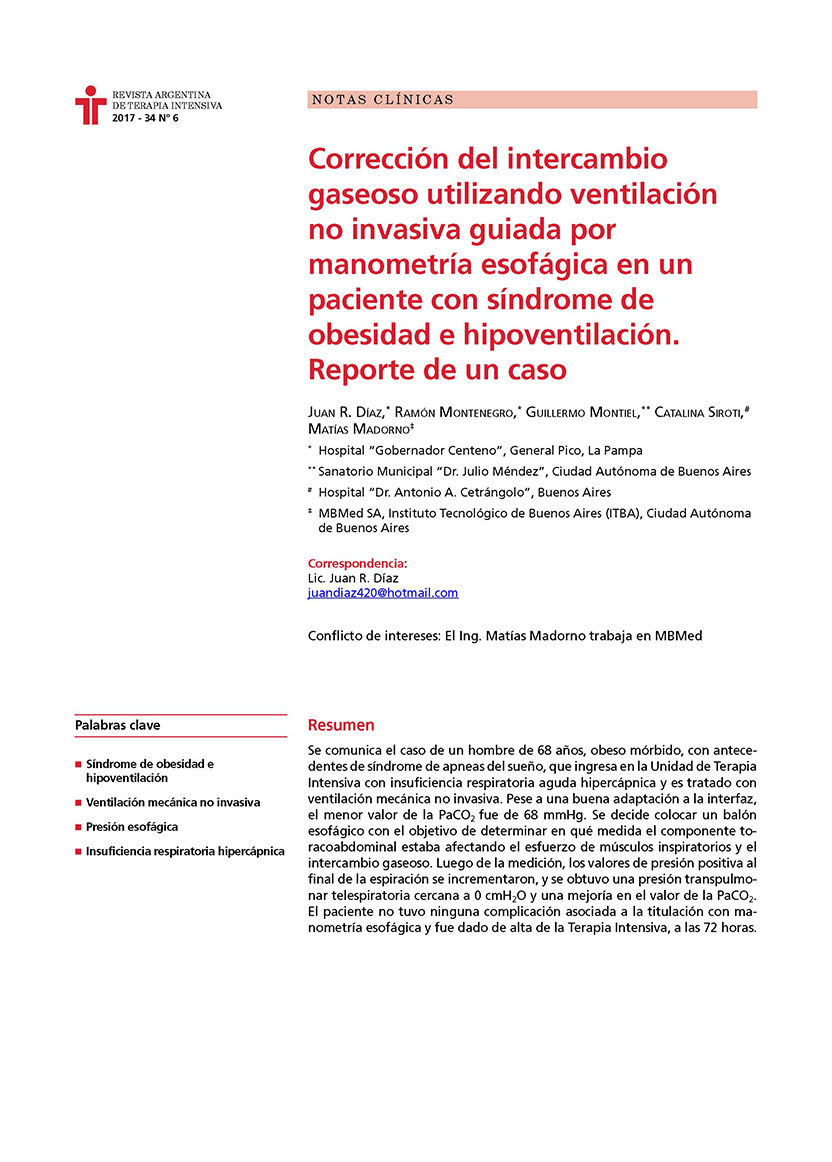Resumen
Presentamos un paciente masculino de 68 años, obeso mórbido con antecedentes de síndrome de apneas del sueño, que ingresa a la unidad de terapia Intensiva con insuficiencia respiratoria aguda hipercápnica y es tratado con ventilación mecánica no invasiva (VMNI). A pesar de lograr una buena adaptación a la interfaz, el menor valor de PaCO2 fue de 68mmHg. Se decide colocar un balón esofágico con el objetivo de determinar en qué medida el componente tóraco abdominal estaba afectando el esfuerzo de músculos inspiratorios y el intercambio gaseoso. Luego de la medición, los valores de presión positiva al final de espiración (PEEP) se incrementaron, obteniéndose una presión transpulmonar telespiratoria (PLesp) cercana a 0 cmH2O, una y una mejoría en el valor de PaCO2. El paciente no presentó ninguna complicación asociada a la titulación con manometría esofágica y fue dado de alta de la terapia intensiva a las 72 horas.
Referencias
Extreme Obesity associated with alveolar hypoventilation; a Pickwickian Sindrome.Bickelmann AG, Burwell CS, Robin ED, Whaley RD, Am J Med. 1956; 21: 811-8.
The obesity hypoventilation syndrome. Olson AL, Zwillich C. Am J Med 2005; 118: 948-56.
Obesity Hypoventilation syndrome as a spectrum of respiratory disturbances during sleep. Pipper AJ, Grunstein RR. Chest 2001; 120: 1231-8.
Characteristics of Patients With the ''Malignant Obesity Hypoventilation Syndrome'' Admitted to an ICU Paul E. Marik and Himanshu Desai J Intensive Care Med 2013 28: 124
Noninvasive Ventilation in Acute Hypercapnic Respiratory Failure Caused by Obesity Hypoventilation Syndrome and Chronic Obstructive Pulmonary Disease Andres Carrillo, Miquel Ferrer, Gumersindo Gonzalez-Diaz, Antonia Lopez-Martinez, Noemi Llamas, Maravillas Alcazar, Lucia Capilla, and Antoni Torres
The Obesity Hypoventilation Syndrome Can Be Treated With Noninvasive Mechanical Ventilation Juan F. Masa, MD; Bartolome R. Celli, MD, FCCP; Juan A. Riesco, MD; Manuel Herna Ìndez, MD; Julio Sa Ìnchez de Cos, MD; and Carlos Disdier, MD CHEST 2001; 119:1102–1107
Optimal PEEP Guided by Esophageal Balloon Manometry. Tom Piraino and Deborah J Cook Respiratory Care april 2011 vol 56 no 4
Mechanical Ventilation Guided by Esophageal Pressure in Acute Lung Injury. November 13, 2008 vol. 359 no. 20 Daniel Talmor, M.D., M.P.H., Todd Sarge, M.D., Atul Malhotra, M.D., Carl R. O’Donnell, Sc.D., M.P.H. Ray Ritz, R.R.T., Alan Lisbon, M.D., Victor Novack, M.D., Ph.D., and Stephen H. Loring, M.D.
Physiology of obesity and effects on lung function Cheryl M. Salome, Gregory G. King, Norbert Berend J Appl Physiol 108: 206–211, 2010.
Observational study of the effect of obesity on lung volumes Joerg Steier, Alan Lunt Nicholas Hart, Michael I Polkey, John Moxham
Hipercapnia. Steven E, Weinberger MD, Richard MD, Schwartzstein and Woodtow Weiss New England Journal of Medicine. Vol. 321; N 8: 1225-1230.
Bench-to-bedside review: Carbon dioxide Gerard Curley, John G Laffey and Brian P Kavanagh Curley et al. Critical Care 2010, 14:220.
A simple method for assessing the validity of the esophageal balloon technique. Baydur A, Behrakis PK, Zin WA, Jaeger M, Milic-Emili J. Am Rev Respir Dis. 1982;126:788–91.
Respiratory restriction and elevated pleural and esophageal pressures in morbid obesity Negin Behazin, Stephanie B. Jones, Robert I. Cohen, and Stephen H. Loring J Appl Physiol 108: 212–218, 2010.
Diaphragm activity in obesity. Lourenco RV. J Clin Invest 1969;48:1609–14.
Uso de Cpap en Adultos con SÃndrome de apneas obtructivas durante el sueño después de prescipción en un hospital público de referencia de la ciudad de México. Luis Torre Bouscoulet, Elodia López Escárcega, Armando Castonera, Maldonado Juan Carlos, Vazquez Garcia, Maria sonia Meza Vargas y Rogelio Pérez-Padilla. Arch BronconeumologÃa 2007;43(1):16-21.
Big breathing: the complex interaction of obesity, hypoventilation, weight loss, and respiratory function Amanda J. Piper and Ronald R. Grunstein. J Appl Physiol 108: 199–205, 2010.
The influence of severe obesity on non- invasive ventilation (NIV) strategies and responses in patients with acute hypercapnic respiratory failure attacks in the Icu G. Gursel , M. Aydogdu, G. Gulbas, S. Ozkaya , S. Tasyurek, F. YildIrim Am J Respir Crit Care Med Vol 186, Iss. 12, pp 1279–1285, Dec 15, 2012
Positive end expiratory pressure improves respiratory function in obese but not in normal subjects during anesthesia an d parálisis.Pelosi P, Ravagnan I, Giurati G, et al. Anesthesiology 1999 91:1221-31
La revista no retiene los derechos de reproducción (copyright) por lo que los autores pueden volver a publicar sus trabajos con la sola mención a la fuente original de publicación.

